When I first tried lion’s mane mushrooms, I was unsure. As someone who loves cooking with fungi, I’d heard they were special. They were said to taste like seafood, which was intriguing for vegetarian dishes. What does lion’s mane taste like?
Lion’s mane mushrooms are unlike other mushrooms. They have a complex flavor. It’s sweet, nutty, and rich, like crab or lobster. This unique taste makes them a hit with chefs who want new meat options.
My cooking tests showed lion’s mane mushrooms are meaty and hearty. They work well in many dishes. Whether you sauté, roast, or add them to stews, they add a special touch.
Key Takeaways
- Lion’s mane has a seafood-like taste resembling crab or lobster
- Offers a unique umami flavor with sweet and nutty undertones
- Versatile in cooking, serving as an excellent meat alternative
- Available in fresh and powder form
- Native to North America, Europe, and Asia
Understanding Lion’s Mane Mushroom
I’m deeply interested in wild mushroom cuisine, and the lion’s mane mushroom has caught my eye. It’s a standout in the world of foraging mushrooms. It has unique traits and health benefits.
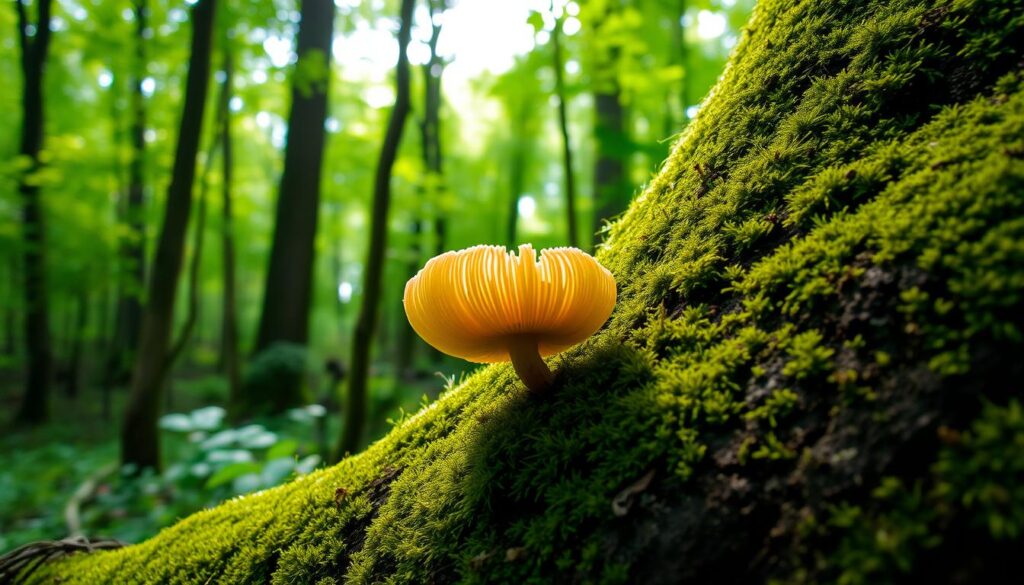
The Fungal Marvel Unveiled
Lion’s mane (Hericium erinaceus) looks like a white waterfall of tendrils. It’s been valued for its medicinal powers in traditional practices.
- Scientific Name: Hericium erinaceus
- Common Varieties:
- Pom Pom (Hericium erinaceus)
- Tufted Lion’s Mane (Hericium americanum)
- Coral Tooth (Hericium corraloides)
Natural Habitat and Growth Patterns
Exploring wild mushroom cuisine, I learned a lot about lion’s mane. They grow in cool weather on hardwood trees in North America and Asia. They like dying or dead trees, often found in tree wounds or where branches have fallen.
| Characteristic | Details |
|---|---|
| Maximum Size | Up to 10 pounds |
| Peak Season | Late summer through winter |
| Availability | Farmers’ markets, gourmet vendors, Asian markets |
In Traditional Chinese Medicine, lion’s mane is celebrated for supporting neurological and gastric health.
For those into foraging mushrooms, lion’s mane is a great find. Its unique look makes it easy to spot. But, always get expert advice before picking wild mushrooms.
The Flavor Profile of Lion’s Mane
Exploring the taste of Lion’s Mane is a thrilling adventure. These mushrooms have a unique flavor that stands out from others. My journey with Lion’s Mane has opened up a world of unique mushroom tastes that will amaze anyone.
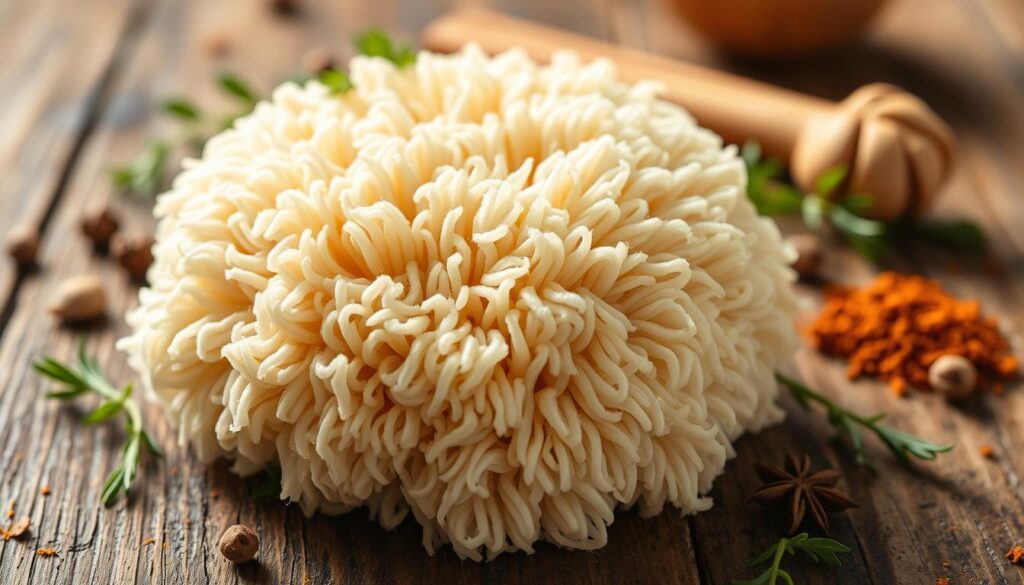
Earthy and Umami Notes
Lion’s Mane has a remarkable flavor. It combines earthy and umami notes in a delicate way. Its taste is subtle yet complex, like seafood with a touch of sweetness.
The mushroom has a mild, almost buttery essence. This makes it perfect for many dishes.
- Sweet and nutty undertones
- Subtle umami flavor
- Delicate seafood-like taste
Texture That Transforms Dishes
Lion’s Mane’s texture is truly unique. When cooked, it becomes meat-like, changing vegetarian dishes. It tastes like crab or lobster, adding culinary magic to any dish.
“Lion’s Mane is nature’s culinary chameleon, with a taste that goes beyond traditional mushrooms.”
Each type of Lion’s Mane has its own flavor. From Pom Pom to Coral Tooth, they all add something special. Roasting or grilling them makes their nutty flavor even better, adding a crispy texture to dishes.
Cooking Lion’s Mane: Best Methods
Exploring lion’s mane cooking techniques opens up a world of culinary possibilities. These unique mushrooms offer incredible versatility in the kitchen. They transform simple dishes into gourmet experiences. Their distinctive mushroom flavors make them a favorite among home cooks and professional chefs alike.
Sautéing: A Delicious Cooking Technique
Sautéing is my go-to method for preparing lion’s mane mushrooms. The process is straightforward and brings out the most incredible flavors. Here’s my recommended approach:
- Tear mushrooms into bite-sized pieces
- Heat butter or olive oil in a skillet
- Cook for 3-5 minutes until edges turn golden brown
- Season with sea salt and soy sauce
Roasting for Intense Flavor
Roasting transforms lion’s mane into a crispy, flavor-packed delicacy. The high heat concentrates its natural umami taste. This creates a meat-like texture that’s absolutely irresistible.
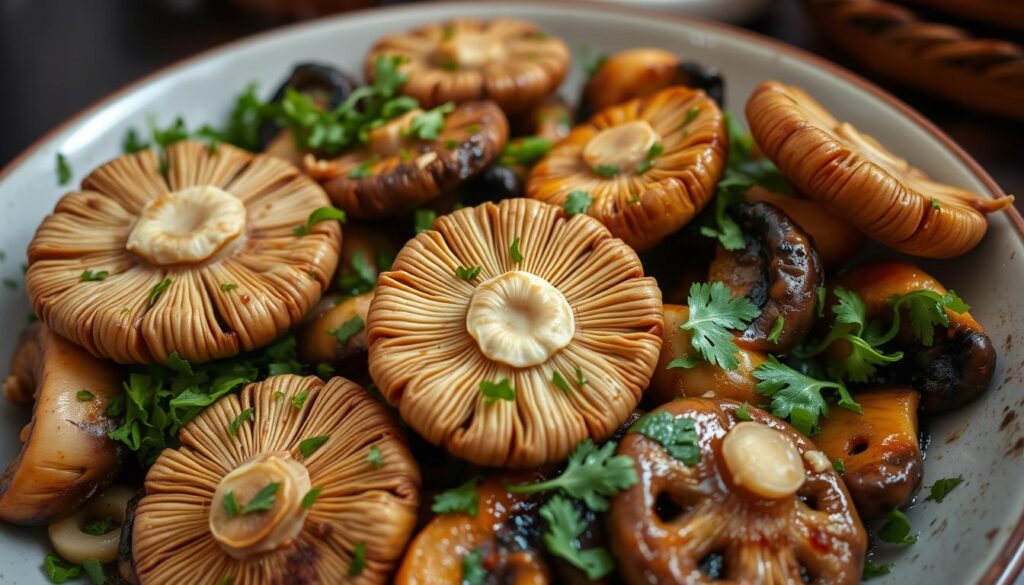
Soups and Stews: A Hearty Addition
Lion’s mane mushrooms excel in liquid-based dishes. They absorb surrounding flavors while maintaining a substantial, almost seafood-like texture. I love adding them to vegetable soups and hearty stews for an extra layer of complexity.
| Cooking Method | Flavor Intensity | Texture |
|---|---|---|
| Sautéing | Medium | Crispy edges, tender center |
| Roasting | High | Crisp exterior, meaty interior |
| Stews | Mild to Medium | Soft, absorbent |
“Cooking lion’s mane is like discovering a new culinary secret – unexpected, delightful, and always memorable.”
Pro tip: Store fresh lion’s mane in a paper bag in the refrigerator, where they’ll stay fresh for up to five days. Always cook them quickly to preserve their delicate mushroom flavors and unique texture.
Personal Experience with Lion’s Mane Taste
Exploring culinary fungi, I discovered the lion’s mane mushroom. It was a taste revelation. The flavor is delicate, like seafood, and it excited my taste buds.
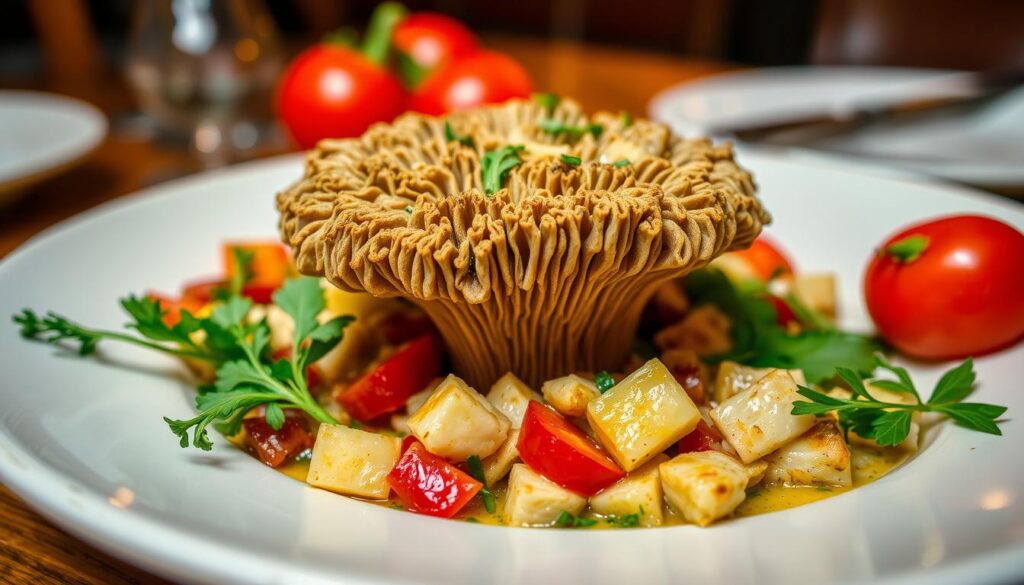
First Impressions
My first time with lion’s mane was impressive. It feels like crab or lobster meat. Its mild, sweet taste makes it great for cooking.
Pairing Suggestions
My experiments showed great ways to use lion’s mane:
- Sautéed with garlic and butter
- Roasted with fresh herbs
- In pasta dishes
- As a meat substitute in sandwiches
For the best flavor, try these seasonings:
| Seasoning | Flavor Enhancement |
|---|---|
| Garlic powder | Adds depth and umami |
| Salt | Brings out natural sweetness |
| Butter | Creates rich, smooth texture |
Lion’s mane is incredibly versatile. It’s great in vegan crab cakes and roasted dishes. Its unique taste keeps surprising and pleasing me.
Nutritional Benefits and Taste
Exploring edible mushrooms like lion’s mane is fascinating. It has changed my view on food, thanks to its nutritional profile.
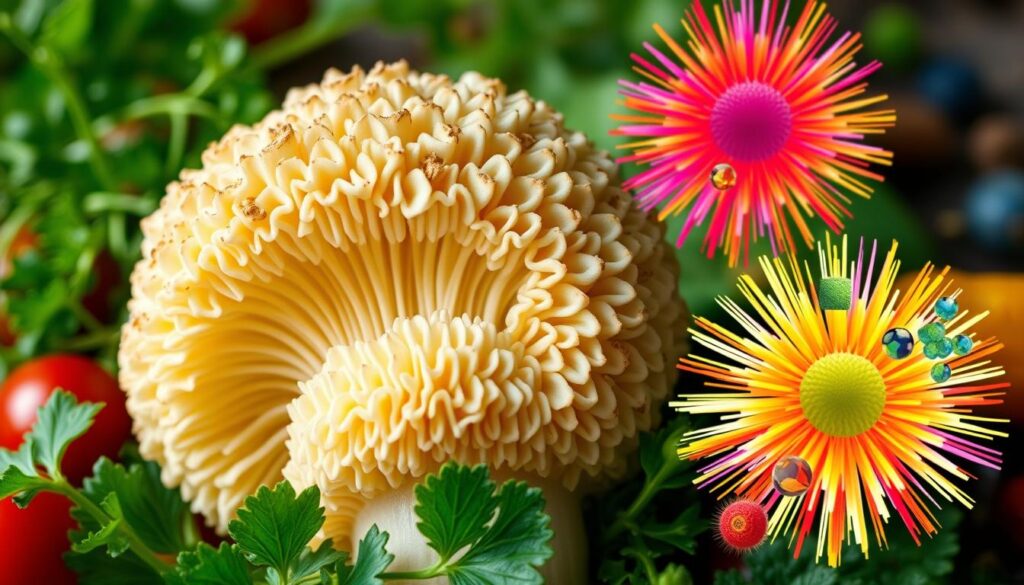
Nutrition’s Impact on Flavor
Lion’s mane mushrooms taste unique. Their flavor comes from their vitamins and minerals. This makes them taste more complex than usual.
- Vitamin B complex (thiamine, riboflavin, niacin)
- Essential minerals like zinc and iron
- Powerful antioxidant compounds
Health Benefits That Enhance Enjoyment
Research shows lion’s mane mushrooms are amazing. A 2020 study found they help people with mild Alzheimer’s think better.
| Health Benefit | Research Findings |
|---|---|
| Cognitive Function | Improved test scores after 49 weeks of supplementation |
| Mental Health | Potential reduction in anxiety and depression symptoms |
| Nervous System Support | Potential nerve growth factor stimulation |
The more I learn about lion’s mane, the more I appreciate its incredible nutritional complexity.
Lion’s mane mushrooms do more than just taste good. They help with inflammation, boost the immune system, and balance gut health. Every bite feels rewarding when you know how it benefits you.
Conclusion: My Thoughts on Lion’s Mane
Lion’s mane mushrooms are truly unique in the culinary world. Their taste is unlike most mushrooms, with a seafood-like flavor that surprises many. It’s a mild, sweet taste that can make any dish special.
Should You Try It?
Definitely try them. Lion’s mane mushrooms are a great choice for those looking for plant-based foods. They’re not only tasty but also good for your health. They support your brain and immune system, making them a great addition to your meals.
Final Recommendations
Try different ways of cooking lion’s mane mushrooms to find your favorite. Look for mushrooms from trusted sources. They’re versatile and healthy, making them a great addition to your kitchen.
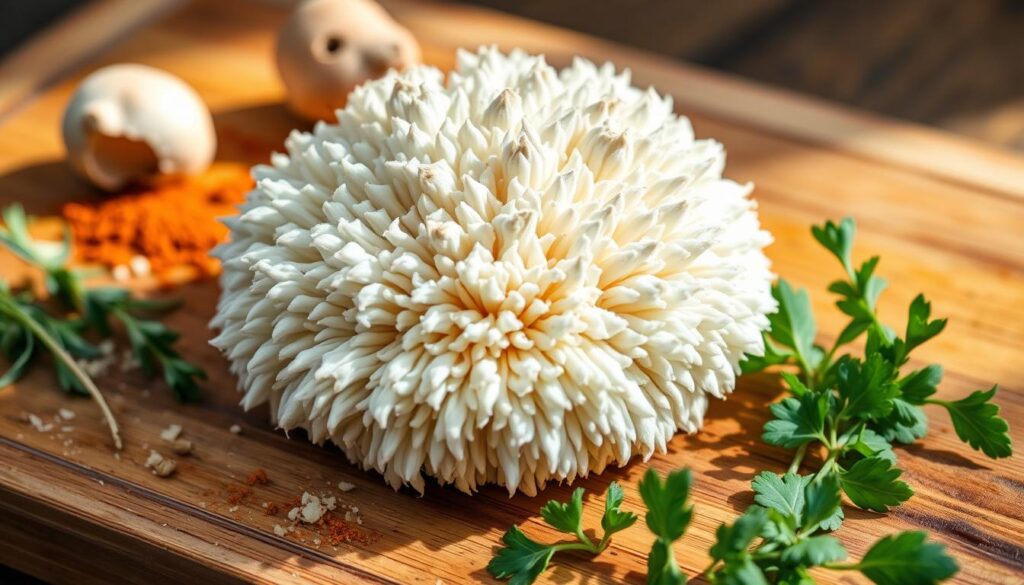
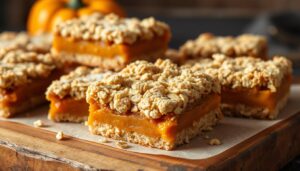


2 thoughts on “What Does Lion’s Mane Taste Like?”